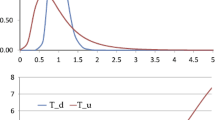Abstract
We prove a risk-neutral pricing formula for a large class of semimartingale processes through a novel notion of weak time-differentiability that permits to differentiate adapted processes. In particular, the weak time-derivative isolates drifts of semimartingales and is null for martingales. Weak time-differentiability enables us to characterize no-arbitrage prices as solutions of differential equations, where interest rates play a key role. Finally, we reformulate the eigenvalue problem of Hansen and Scheinkman (Econometrica 77:177–234, 2009) by employing weak time-derivatives.
Similar content being viewed by others
References
Adams, R.A., Fournier, J.J.F.: Sobolev Spaces. Academic Press, San Diego (2003)
Aliprantis, C., Border, K.: Infinite Dimensional Analysis. Springer, Berlin (2006)
Alvarez, F., Jermann, U.J.: Using asset prices to measure the persistence of the marginal utility of wealth. Econometrica 73, 1977–2016 (2005)
Ansel, J., Stricker, C.: Lois de martingale, densités et décomposition de Föllmer Schweizer. Ann. Inst. Henri Poincaré Probab. Stat. 28, 375–392 (1992)
Bachelier, L.: Théorie de la Spéculation. Gauthier-Villars, Paris (1900)
Björk, T.: Arbitrage Theory in Continuous Time, 3rd edn. Oxford University Press, London (2009)
Black, F., Scholes, M.: The pricing of options and corporate liabilities. J. Polit. Econ. 81, 637–654 (1973)
Brezis, H.: Functional Analysis, Sobolev Spaces and Partial Differential Equations. Springer, Berlin (2010)
Carr, P., Geman, H., Madan, D.B., Yor, M.: The fine structure of asset returns: an empirical investigation. J. Bus. 75, 305–332 (2002)
Cox, J.C., Ross, S.A.: The valuation of options for alternative stochastic processes. J. Financ. Econ. 3, 145–166 (1976)
Craven, B.D.: Two properties of Bochner integrals. Bull. Aust. Math. Soc. 3, 363–368 (1970)
Delbaen, F., Schachermayer, W.: A general version of the fundamental theorem of asset pricing. Math. Ann. 300, 463–520 (1994)
Delbaen, F., Schachermayer, W.: The fundamental theorem of asset pricing for unbounded stochastic processes. Math. Ann. 312, 215–250 (1998)
Diestel, J., Uhl, J.J.: Vector Measures. Am. Math. Soc., Providence (1977)
Duffie, D.: Dynamic Asset Pricing Theory. Princeton University Press, Princeton (2010)
Émery, M.: Compensation de processus VF non localement intégrables. In: Azema, J., Yor, M. (eds.) Séminaire de Probabilités XIV. Lecture Notes in Mathematics, vol. 784, pp. 152–160. Springer, Berlin (1980)
Föllmer, H., Schied, A.: Stochastic Finance: An Introduction in Discrete Time, 2nd edn. de Gruyter, Berlin (2004)
Föllmer, H., Schweizer, M.: Hedging of contingent claims under incomplete information. In: Davis, M.H.A., Elliott, R.J. (eds.) Applied Stochastic Analysis, Stochastics Monographs, vol. 5, pp. 389–414. Gordon and Breach, London/New York (1991)
Geman, H., El Karoui, N., Rochet, J.C.: Changes of numéraire, changes of probability measure and option pricing. J. Appl. Probab. 32, 443–458 (1995)
Hansen, L.P., Heaton, J.C., Li, N.: Consumption strikes back? Measuring long-run risk. J. Polit. Econ. 116, 260–302 (2008)
Hansen, L.P., Richard, S.F.: The role of conditioning information in deducing testable restrictions implied by dynamic asset pricing models. Econometrica 55, 587–613 (1987)
Hansen, L.P., Scheinkman, J.A.: Long-term risk: an operator approach. Econometrica 77, 177–234 (2009)
Karatzas, I., Shreve, S.: Brownian Motion and Stochastic Calculus, 2nd edn. Springer, Berlin (1991)
Kou, S.G.: A jump-diffusion model for option pricing. Manag. Sci. 48, 1086–1101 (2002)
Lions, J.L.: Optimal Control of Systems Governed by Partial Differential Equations. Springer, Berlin (1971)
Margrabe, W.: The value of an option to exchange one asset for another. J. Finance 33, 177–186 (1978)
Merton, R.C.: Option pricing when underlying stock returns are discontinuous. J. Financ. Econ. 3, 125–144 (1976)
Meyer, C.D.: Matrix Analysis and Applied Linear Algebra. SIAM, Philadelphia (2000)
Modigliani, F., Miller, M.H.: The cost of capital, corporation finance and the theory of investment. Am. Econ. Rev. 48, 261–297 (1958)
Platen, E., Bruti-Liberati, N.: Numerical Solution of Stochastic Differential Equations with Jumps in Finance. Springer, Berlin (2010)
Protter, P.E.: Stochastic Integration and Differential Equations, 2nd edn. Springer, Berlin (2004)
Revuz, D., Yor, M.: Continuous Martingales and Brownian Motion, 3rd edn. Springer, Berlin (1999)
Samuelson, P.A.: Proof that properly anticipated prices fluctuate randomly. Ind. Manage. Rev. 6(2), 41–49 (1965)
Severino, F.: Long-term risk with stochastic interest rates. Working paper (2018). Available online at https://ssrn.com/abstract=3113718
Williams, D.: Probability with Martingales. Cambridge University Press, Cambridge (1991)
Acknowledgements
We thank Anna Battauz, Francesco Caravenna, Andrea Carioli, Simone Cerreia-Vioglio, Lars Peter Hansen, Ioannis Karatzas, Luigi Montrucchio, Fulvio Ortu, Emanuela Rosazza-Gianin, Martin Schweizer and two anonymous referees for useful comments. We also thank seminar participants at XL AMASES Annual Meeting in Catania (2016) and at XVIII Quantitative Finance Workshop at Università Bicocca, Milan (2017).
Author information
Authors and Affiliations
Corresponding author
Additional information
Massimo Marinacci and Federico Severino acknowledge the financial support of ERC (grants INDIMACRO and SDDM-TEA respectively).
Appendix: A routine lemma
Appendix: A routine lemma
We state and prove a version of a standard result that is best suited for our purposes.
Lemma A.1
Let \(f:[t,T]\to \mathbb{R}\) be a measurable function.
-
(i)
If \(f\) is bounded, nonnegative, with compact support and \(\int _{t}^{T} f(\tau )g(\tau )d\tau =0\) for any \(g \in C_{c}((t,T))\), then \(f=0\) a.e.
-
(ii)
If \(\int _{t}^{T} f(\tau )g(\tau )d\tau =0\) for any \(g \in C_{c}((t,T))\), then \(f=0\) a.e.
Proof
(i) If \(f\) is strictly positive on a set \(A\) with positive measure, consider the indicator function \(\mathbf{1}_{A}\) and a sequence \((U_{n})\) of continuous positive approximations of \(\mathbf{1}_{A}\), obtained by convolution with a smooth positive kernel. As \(U_{n}\) converges to \(\mathbf{1}_{A}\) in \(L^{2}\), \(0 \leqslant \int _{t}^{T} f(\tau ) \mathbf{1}_{A}(\tau ) d\tau =\lim _{n} \int _{t}^{T} f( \tau ) U_{n}(\tau )d\tau =0\). Consequently, \(f\) is null a.e.
(ii) Suppose that \(f\) is positive with compact support. For any \(N>0\), consider \(f_{N}(s)=\min \{f(\tau ),N\}\). Then,
Therefore, each \(f_{N}\) is null a.e. by (i) and so is \(f\). □
Rights and permissions
About this article
Cite this article
Marinacci, M., Severino, F. Weak time-derivatives and no-arbitrage pricing. Finance Stoch 22, 1007–1036 (2018). https://doi.org/10.1007/s00780-018-0371-9
Received:
Accepted:
Published:
Issue Date:
DOI: https://doi.org/10.1007/s00780-018-0371-9
Keywords
- No-arbitrage pricing
- Weak time-derivative
- Martingale component
- Special semimartingales
- Stochastic interest rates




